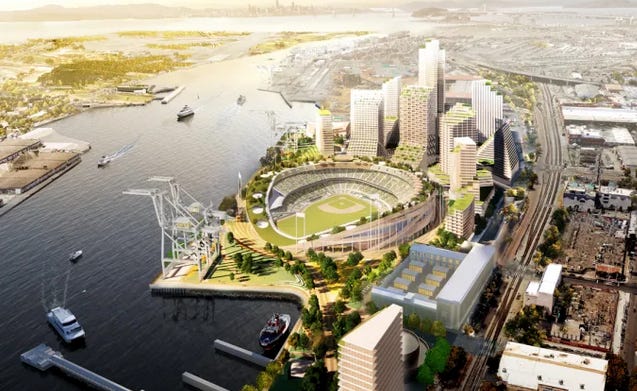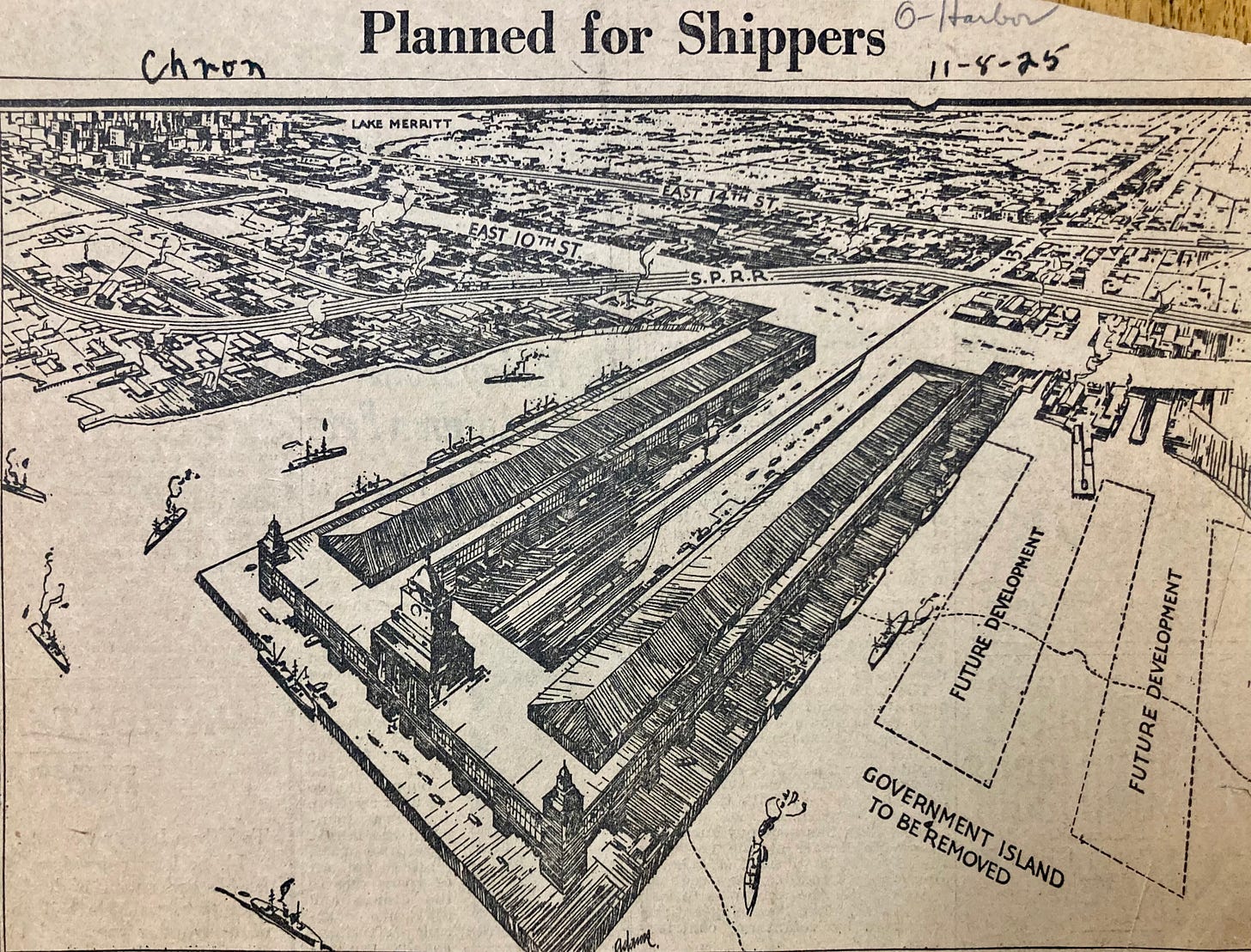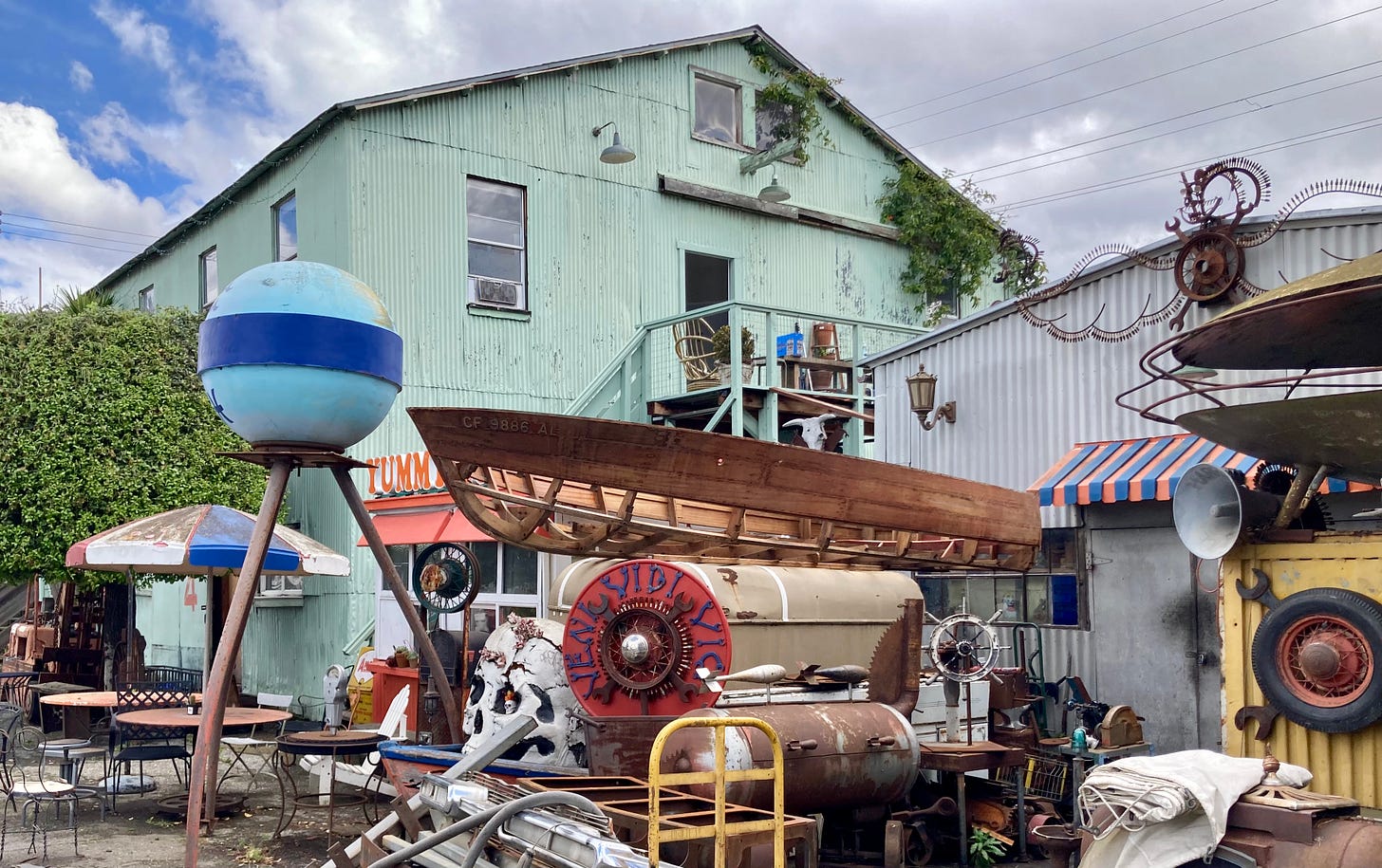One of my favorite pages on the Local Wiki is “Unbuilt Oakland,” which compiles various infrastructure proposals that never broke ground. Looking at these concepts is an invitation to imagine a parallel timeline. Would the Port have become a tourist destination if this rotating flying saucer restaurant had been built? How would downtown be different today if a 55-story tower had been completed in the 1960s? What if a giant monorail connected us to San Francisco instead of the Bay Bridge?
The most infamous unbuilt project in recent memory is the A’s Howard Terminal Stadium, which still looms darkly in the minds of frustrated fans still bitter over the team’s disgraceful exit. The futuristic renderings of that compound promised Oaklanders a waterfront baseball oasis, but in the end it was just a mirage.
There are valuable lessons to be learned from studying why some Big Plans succeed while others fail, but for the most part, I’m fascinated by articles featuring unbuilt aerial gondolas and fantastical architecture simply out of curiosity. This yearning to imagine alternate realities similar to our own is clearly a common impulse, judging by Hollywood’s ongoing obsession with multiverse-themed plots. There’s also a sense of relief that comes with seeing how many bullets we’ve dodged.
During the Gilded Age, railroad magnate Collis Huntington wanted to pave Lake Merritt so that the property could be used as a trainyard. A generation later, a proposal to bisect the Lake with a four-lane highway was thankfully shot down. The gold medal for worst idea, however, goes to the Reber Plan, which proposed filling in most of the San Francisco Bay, except for a few shipping channels.
Recently, I discovered another major project that would have reshaped Oakland significantly. In the Oakland History Center, I found several articles about a plan to construct a series of massive shipping terminals near the present site of Brooklyn Basin. The proposal called for removing Government Island (now named Coast Guard Island) to make room for “one of the finest port structures in America.” Illustrations feature a structure that looks remarkably similar to San Francisco’s iconic Ferry Building…
I’m not sure if it was logistics or the Great Depression that killed this dream, but the proposal was dead by the end of the Roaring Twenties. Personally, I’m glad it died. For my most recent episode, I interviewed a man named Schultz (“just Schultz”), who loved to explore this stretch of Oakland’s waterfront, beginning in the 1950s while he was an art student at the California College of Arts and Crafts. He told me about coming down to the crumbling docks to sketch drawings of old ships and discovering a whole Bohemian community of artists and sailors. All along this neglected shoreline, they lived in houseboats, ramshackle dwellings, and even an abandoned minesweeper.
Sure, there were also functioning wharves, warehouses, repair shops, and the 9th Avenue Terminal, but creative wanderers washed in amongst the estuary’s unused nooks and crannies and many of them decided to stick around this funky enclave. If “one of the finest Port structures in America” had been allowed to dominate this entire area, that never would have happened. In recent decades, much of this waterfront has been “cleaned up” and redeveloped, but one small sliver of the Bohemian past remains – 5th Avenue Marina, where Schultz lived and worked for many years.
Places like 5th Avenue Marina might not be the most “productive” use of space, compared to a cargo terminal, but they bring a different kind of value to Oakland. They’re also a reminder that sometimes the failure of a Big Plan isn’t as bad as it might seem at first. Given time, something will always fill the void. Maybe even something beautiful – or at least interesting…
East Bay Yesterday Updates & Events
Here are my summer boat tour dates (so far): June 7 and 21; July 19 and 26. These tours will feature all new stories and visit some areas of Oakland and Alameda not covered on previous tours. I’ve been working on this new route for months and I can’t wait to kick things off in a few months – don’t sleep on getting tickets!
“Reflections on Lake Merritt,” a documentary that I’m helping to produce, is doing a fundraiser campaign to cover the barebones budget. We only need a few thousand more to get this film across the finish line (after about 3 years of work!), so if you can throw in a few bucks, it would be greatly appreciated. What’s the film about? Watch the trailer to find out.
“16th Street Station could turn into our version of the Parthenon, where it has nothing but walls, which would be very sad. Then everyone will wring their hands about what could have been done to save it.” That scenario has been haunting me ever since I interviewed Feleciai Favroth of Oakland Heritage Alliance for my SF Gate article about a new petition to save the historic train depot. This isn’t just a stunning building – it’s so historically significant that Ron Dellums once compared it to Ellis Island. Please check out the article and sign the petition… and stay tuned for more on this station. I’m working on a podcast and possibly an event to draw even more attention to this endangered landmark.
A few weeks ago, my editor asked me to write a little review of the Black Coffee party at Ogawa Plaza, so of course I used the opportunity to cover the history of City Hall-adjacent events going all the way back to the 1860s. Sadly, I couldn’t quite figure out how to squeeze in mention of the German aerialists who rode a motorcycle across a tightrope suspended between buildings in 1953, but I did cover a lot of territory. If you’re looking for a non-depressing article about The Town, here you go: “Joyous event outside City Hall shows how Oakland will survive.”
The Culture Makers event that I’m moderating at New Parkway Theater with Azucena Rasilla, Natalie Orenstein and Darwin BondGraham is sold out, but I’m trying to make sure that it will be recorded for everyone who can’t make it. Hopefully it will end up as a bonus episode of the podcast and/or posted to YouTube.
Speaking of recent events, if you missed my conversation with Gary Kamiya and Heather Bourbeau about “Overlooked Histories of the Bay,” it’s now available via the Commonwealth Club podcast. Also, the video of my Q&A with Aja Cooper at the East Bay Photo Collective hasn’t been posted yet, but you can see an amazing review of the Raymond Cooper exhibit we were discussing here. Instead of merely writing about the show, local illustrator Fred Noland drew his impressions...
I really appreciated being included in Bill Buchanan’s article bidding farewell to BART’s old fleet of cars, which is finally rolling off into the sunset this week. Check out the piece if you want to see my thoughts on the most cramped commute ever (during the World Series Parade) and BART’s biggest mistake (carpet? really??).
In Other News
Jazz guitarist Calvin Keys has passed away at age 82, following complications due to a stroke. Two of his early albums on Oakland’s Black Jazz label, Shawn-Neeq and Proceed with Caution, have been on heavy rotation at my house since being re-released in 2020. I highly recommend reading this loving obituary from KQED’s Gabe Meline, who does an admirable job of trying to sum up a career that stretched across seven decades.
Why has the Hooper’s Chocolate house sat empty for a decade, despite being located on one of the hippest stretches of Telegraph Ave? That’s the question Susana Guerrero explores in a deep-dive feature on the rise and fall of an East Bay candy empire. Warning: Don’t read this article if you’re hungry. [Free suggestion: Someone should make this conspicuously pink building a pop-up Barbie museum.]
Oaklandside contributor Momo Chang wrote a great profile of William Gee Wong that covers everything from his days growing up in mid-century Chinatown to his 1980s Oakland Tribune career. I haven’t picked up Wong’s new memoir, “Sons of Chinatown,” yet, but now I’m adding it to the top of my reading list.
The A’s have officially abandoned Oakland, but at least there’s a new minor league team coming to town. Instead of trying to suck public money out of our city’s budget like John Fisher, the Oakland Ballers have invested in renovating West Oakland’s storied Raimondi Park. The Ballers’ promo video celebrates the history of the ballfield, which served as a training ground for allstars like Frank Robinson and Curt Flood. Watch it here.
Sponsored Messages
A new art exhibition is now showing at the Berkeley Art Museum and Pacific Film Archive called A Movement in Every Direction: Legacies of the Great Migration. Twelve contemporary artists were commissioned to make works reflecting on the impacts of the Great Migration, a period when millions of Black Americans moved from the South throughout the United States, radically altering the economic, cultural, and political makeup of the country. Many artists drew from their own personal and familial histories, creating works that span generations and mediums, including painting, sculpture, photography, video, and textile. A Movement in Every Direction prompts us to consider how the Great Migration—and migration in general—have been a part of our own stories and our shared history, here in the East Bay and beyond. This exhibition is on view through September 22nd at BAMPFA in downtown Berkeley. Gallery admission is free on the first Thursday of every month. You can read a review of the exhibition by KQED’s Ariana Proehl here.
According to the California Department of Public Health, Black babies in the Bay Area are two to three times more likely to be born too soon or too small or to die before their first birthday, compared to white babies. Scientific evidence points to structural racism and a systemic lack of cultural awareness by providers among the causes of these disparities. To address this inequality in health outcomes, doctors and nurses at UCSF Benioff Children’s Hospital Oakland created BLOOM: the Black Baby Equity Clinic. This new clinic at UCSF Children’s matches mothers and families with culturally responsive pediatric care, and provides help like lactation counseling, check-ups, and critical support. UCSF Benioff Children’s Hospitals are committed to providing equitable care that makes a difference.
Finally
Happy birthday to KPFA-FM, which launched on April 16, 1949, as the first listener-funded radio station in the country. To honor this 75th anniversary, I’ll be doing a presentation about KPFA history on June 3 at Shotgun Players Theater in Berkeley. The event is called “Rebel Airwaves” and my goal is not only to cover the station’s major milestones but to share lots of fun stories and images that I’ve been digging up in my research. You can get tickets by going to the KPFA support page and selecting the “Rebel Airwaves” event under the under “Pledge Gifts” section. A minimum donation of $100 required for this event.
Thanks for reading! And extra special thanks to those of you supporting East Bay Yesterday through Patreon or through a paid subscription to this Substack. The only reason that I’m able to devote so much time to this project is because of your generosity.
-Liam
PS: Another way to support East Bay Yesterday is by purchasing my t-shirts and hats from Oaklandish.










In going through my collection of interesting documents I found a report dated October 1963 by Victor Gruen Associates: East Bay Shores. This report was prepared for The AT&Sf Railway Company, otherwise known as Santa Fe.. From the report, Santa Fe, in the 1920s, had acquired 3,400 acres of submerged tidelands along the east shore of San Francisco Bay. This stretched from the Bay Bridge to Point Richmond. This report in 1963 was an effort to develop this land. In the report was a review of previews development schemes starting with the Rees plan of 1913- industry and an aquatic Park. In 1920 and 1931 there had been proposals for harbor development and industry filling in most of the area. In 1940, 1945, and 1948 there had been proposals for an airport. And of course in the 1940s there had been the infamous Reber Plan. In this 1963 report, development would be a mix of residential, recreation, educational, and industry. A really fascinating part of the plan was the inclusion of what was to be called the Bayshore Freeway. This was planned by the Division of highway to be a duplicate of the Eastshore Freeway, located some 2000 feet to the west. It was said that their traffic projections in the 1960s showed that both freeways would be required by 1980!!
This 1963 plan did not result in any development of the Santa Fe property, so in 1968, Victor Gruen Associates prepared 'The Santa Fe Plan: for development of the East Bay Shores'. This plan showed residential development in the southerly portions and industrial in the northerly/Richmond portions. The planned Bayshore Freeway westerly of the Eastshore Freeway was retained.
It is fascinating to see these old planning studies and to think about what could have been built!